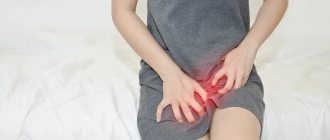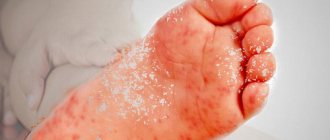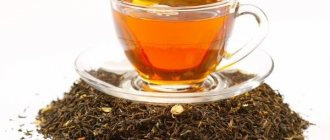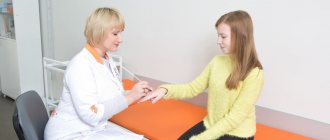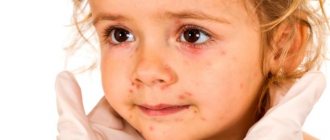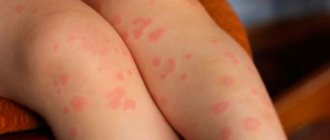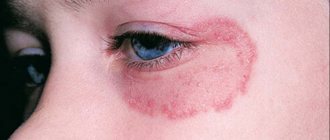Atopic dermatitis is a chronic skin disease. Due to disruption of biochemical processes, excessive dryness, peeling, redness occurs, inflammatory processes develop, and itching is felt. It develops under the influence of allergens, and is often combined with bronchial asthma, food allergies, and allergic rhinitis. It appears in the first years of life, most often before 12 months or at the age of 2-3 years, when the children's diet expands and many allergenic foods enter it. With proper treatment and care, the disease enters the stage of stable, long-term remission, but can manifest itself in adolescents, young and elderly people during contact with allergens, a weakened immune system, and after stress.
Symptoms
With atopic dermatitis in children, skin tightness, redness appears, the skin flakes, feels rougher to the touch, and thickening may appear. Microscopic bubbles form, around which moisture is released. The child is worried and scratches the affected areas. When an infection occurs, local inflammation develops and the wounds heal poorly. With significant spread in young children, general intoxication of the body manifests itself: the temperature rises, the peripheral lymph nodes enlarge. Due to severe itching, sleep and appetite are disrupted, and the child often cries. Dermatitis most often affects the face, neck, armpits, scalp, groin, areas under the earlobes, popliteal fossae, and elbows.
What is a rash
A rash is an inflammation or irritation of the skin that causes the skin to become red, uneven, and may peel. The rash may be accompanied by itching and sometimes fever. Keep in mind that a child's rash could be a sign of an allergic reaction, which may require immediate medical attention. In this article we will talk about the most common types of rashes in young children. Our list is not exhaustive, and if you have any questions or concerns about your baby's skin, be sure to contact your pediatrician.
Prevention
Atopy is translated from Latin as strangeness. The causes of the disease cannot always be determined. But long-term observation of patients and members of their families has revealed that it develops more often:
- with a genetic predisposition - if the parents are healthy, the probability of developing dermatitis in the child is 20%, if one of them is sick - 50%, if both are sick - 80%;
- in case of unfavorable pregnancy, active or passive smoking of the expectant mother, consumption of food that provokes allergy attacks, use of certain medications;
- when a newborn is in a dusty room, insufficient care for his personal hygiene;
- with prolonged exposure to allergens that enter the child’s body with food through the respiratory tract.
Breastfeeding for up to 6 months and avoiding allergy-provoking foods reduces the likelihood of developing atopic dermatitis.
Rash associated with food allergies
When introducing complementary foods, try to add one food item to your baby's diet every three to five days to rule out food allergies. If any product causes an allergy in your baby, you may notice red cheeks on your baby and a rash on your baby's body. Other possible symptoms of food allergies are vomiting and diarrhea. If you notice any of these symptoms, consult your doctor.
What to feed a child with atopic dermatitis
In order not to provoke an exacerbation of dermatitis, to relieve itching and redness of the skin, you need to follow a diet. Foods that burden the immune system are excluded from the children's diet: citrus fruits, chocolate, eggs, honey, seafood. Red (strawberries, cherries, currants, apples) and exotic (mangoes, coconuts, pineapples) fruits are dangerous.
Split meals are recommended: small portions every 3-4 hours. It is better to boil, stew, bake, but not fry. Do not use spices, black pepper. The diet should be balanced and contain enough protein, vitamins, and microelements.
Avoid giving your child sugary carbonated drinks, chips, crackers and other snacks for as long as possible. If the infant is receiving breast milk, introduce new foods carefully. Add the product once a week to make sure it doesn't cause breakouts. After meals and between meals, offer your baby clean boiled water.
Hives
Urticaria is a fairly extensive rash on a child’s body, accompanied by itching and the appearance of blisters that have a rich pink color. The rash gets its name from its resemblance to nettle burns. Hives can appear in one area or throughout the baby’s body and even move from one area to another over the course of several hours. Causes of urticaria:
- Infection (viral, bacterial, parasitic)
- Food allergies, such as peanuts, tree nuts, eggs, dairy, and seafood
- An allergic reaction to contact with something, such as an animal or plant
- Insect bite, including bee sting
- Reaction to medications (such as antibiotics)
For hives, it is usually recommended to take antihistamines to help relieve the itching. A cold compress applied to the area of skin affected by hives can also bring relief. If your child has difficulty swallowing or wheezes, call an ambulance immediately, as these may be symptoms of anaphylactic shock.
Skin care
To relieve itching and prevent infection of the affected skin, you need to properly care for your skin:
- It’s better not to take a shower, but to take a cool bath for about 10 minutes; use medicated bathing products with a soft base that cleanse but do not dry the skin;
- moisturizing and softening – the skin should not be dry to prevent flaking and cracking; regularly apply a moisturizer recommended by a dermatologist;
- Do not let your child scratch the affected areas to avoid infection - apply anti-itching products to the atopic areas.
Cream or gel relieves discomfort during an exacerbation and allows you to sleep, eat, and play peacefully. Apply the drug to cleansed skin, treat atopic lesions and the areas around them. Do not exceed the recommended dosage and frequency of use.
Caring for a child with dry, sensitive skin - tips for parents
At the moment of birth, the child finds himself in new conditions; he moves from the dark, warm and constantly moist uterine cavity into the air space.
The largest organ of the body, the skin, which protects the baby from all external negative influences, is gradually being rebuilt to a new level of work. In the first months of life, the skin is not ideal: it turns red, peels, becomes dry, or becomes covered with small pimples.
These are completely acceptable reactions after a long stay in a humid environment, surrounded by amniotic fluid. The functioning of the skin in the air, where temperature, humidity and the speed of air flow constantly fluctuates, requires a certain “tuning”. This takes on average about a month.
Therefore, it is important to properly care for your baby from the first days, maintaining the health of his skin, and to know what products are needed, how to avoid problems, what is needed for hygiene, how to help with minor injuries, rashes, and itching?
Sensitive skin is a major problem
A baby's skin is thin, delicate and more sensitive than that of an adult. This is due to the structural features of the children's epidermis: the cells do not adhere so tightly to each other, lose moisture faster and peel off at the slightest negative impact.
The sweat and sebaceous glands are just adjusting their work, so they either work too sluggishly, then the skin dries and cracks, or they produce an excess of secretions - then pimples, clogged pores and sweating occur.
Considering that approximately 20% of children have an initial hereditary predisposition to allergies, including skin allergies, proper care of the baby from the first days after birth becomes one of the main tasks.
Risk areas are the skin in the diaper area, in contact with urine and stool, the face, and natural folds of the skin.
The most common problems for children are diaper rash, prickly heat and dry, flaking skin, even cracking in particularly affected areas. This is not a very pleasant sight, especially if it is just a baby who himself will not complain of irritation and pain, itching and discomfort.
Dry skin of a child can be easily eliminated with the help of simple home measures; only in rare cases does the baby need the help of a doctor and the use of any medications.
Features of a newborn
To understand why dry and hypersensitive skin occurs in children, parents must understand the specific physiological changes in the epidermis of the newborn.
Babies are born covered with a whitish coating of vernix caseosa (vernix caseosa). The cream-like substance coats and protects the baby's skin from amniotic fluid until the baby is born. After childbirth, the lubricant is wiped off the skin, and the epidermis is exposed to air and bacteria, which gradually colonize its skin.
Deprived of lubrication, the top layer of skin dries out and peels off a few days after birth. Consequently, some dry skin is common in newborns.
Experts say newborns don't need extra moisturizer or lotions in their first month of life. They need to properly adjust the functioning of the glands and the activity of the upper layers of the epidermis to work in new conditions.
Excessive use of creams, cosmetics and various moisturizers during this period can only do harm!
As a child gets older, dry skin develops in response to certain external and internal irritants. In this situation, parental attention and immediate elimination of irritants are important.
Dry skin in children: what factors are to blame?
Dry skin (medical term: xeroderma) is mainly caused by increased loss of moisture, which leads to cracking and peeling of the epidermis, the outermost layer of the skin.
Factors that affect the functioning of the epidermis and its condition:
Weather . Extreme cold and extreme heat significantly affect humidity, causing the skin to lose moisture and dry out at a high rate.
Temperature and humidity in the nursery. If the temperature at home is very high or too low, the air in the rooms will gradually lose moisture and dry out the child’s skin.
By the way, heaters and air conditioners dry out the air a lot, so humidifiers for an apartment are a very useful thing, especially if you have kids.
Long baths. Bathing a child for too long washes away the natural protective hydrolipidic film on the skin secreted by the sebaceous glands. Taking a bath in potassium permanganate-treated or chlorinated water or herbal decoction damages and dries out the skin.
Hard soap. Regular, non-baby soap is too “harsh” for a child’s skin, which causes it to become dry. “Adult” cosmetics and bathing products have a similar effect.
These were common conditions that a child might encounter in everyday life. But dryness and irritation can also be a sign of a serious problem with your baby's skin.
There are many reasons that explain dry skin in children. But it is important for parents to know what symptoms should cause alarm when the baby needs help.
Actually, parents quickly notice dry skin, and quite simple methods eliminate irritation. But there are a number of symptoms that require you to visit a pediatrician or dermatologist.
These include:
• bleeding from cracked skin; • severe itching, which makes the child whiny and irritable; • pus or yellow crusts on dry skin; • swelling of the epidermis, increased temperature; • dry skin, causing colic attacks.
How to care for your baby's skin?
Preventing and treating dry skin is quite simple and all you need to do is follow a few simple steps and procedures.
Limit your baby's bath time. Prolonged stay in the bath, especially in hot water, washes away the natural protective film from the skin, leaving the epidermis vulnerable to the external environment. Experts recommend limiting bath time to ten minutes in warm (not hot) water.
Use mild, delicate soap. Always use soap specifically made for children as it does not contain harsh or harmful chemicals. Choose bathing gels and liquid soaps with added moisturizers as they protect the skin. Avoid soaps containing dyes and fragrances, as they quickly dry out the skin and cause allergies.
Follow the washing regime. Even if it is a gentle soap, it does not have to be used daily. It is enough to wash the child’s body and head with shampoo and soap 2-3 times a week or when the baby is very dirty. The rest of the time, washing with warm water is enough.
Use moisturizing lotions after bathing your baby . From about one month of age, moisturize your baby's entire body immediately after a bath using a hypoallergenic body lotion. The fats in moisturizing lotion form a thin layer on the skin that replenishes and prevents further moisture loss. Using moisturizers is the safest home remedy for baby's sensitive skin.
Choose clothes made from natural fabrics and without tight seams. Natural fabrics such as cotton are soft, non-allergenic and allow the skin to breathe easily. If your child has dry skin, it is important to switch to cotton clothes.
Use baby detergent. Children's clothes and bedding should be washed only with special baby powder without caustic chemicals or allergens. Look for a detergent designed for children with sensitive skin.
Use a humidifier. Dry air is the worst enemy of a child's skin. Use a portable cool mist humidifier that maintains a constant level of air humidity and prevents moisture loss from the skin.
Dress your child according to the weather. It is important that during walks the child does not freeze, but does not overheat. Very hot or very cold air lacks moisture, which can increase skin dryness and irritation.
Don't forget to give your child water more often . In hot weather or when the air is very dry, the body loses more moisture. Therefore, it is important to monitor the baby’s drinking regime. Infants need to be put to the breast more often; artificial babies and children receiving complementary foods should be offered a bottle of water more often.
Simple prevention and treatment steps can help relieve dry skin quickly. Parents should constantly ensure that their child has silky smooth skin.
Alena Paretskaya
Photo depositphotos.com
The opinion of the author may not coincide with the opinion of the editors
Rating of the best remedies for atopic dermatitis
To treat atopic dermatitis, use special children's products recommended by a dermatologist. During exacerbations, medications are prescribed for oral administration, application to atopic areas and general body care:
- preparations for removing allergens from the body - Enterosgel, Lactrofiltrum, Enterodes;
- skin softening products – Atopic cream for daily care;
- drugs that relieve itching - Panthenol spray;
- bathing products - soft shower gels for atopic dermatitis should be purchased at the pharmacy: dermatologists recommend using Atopic bathing gel from head to toe.
Bathing
After a light shower to thoroughly cleanse your entire body, apply Atopic Bathing Gel to damp skin from head to toe, massage lightly and rinse thoroughly. Dry your baby with a soft towel using blotting, but not rubbing, movements. After water treatments, apply Atopic skin softening cream for daily care. Apply it several times throughout the day: after washing your hands and washing your face.
When taking a bath, the water temperature should not exceed 36 degrees. Place your child in the water and offer him toys or other entertainment. After 5-7 minutes, apply Atopic Bathing Gel from head to toe and rinse well. After bathing, use Atopic cream for daily care, and if itching bothers you, let the cream absorb, and then treat the affected skin with an anti-itching drug.
Roseola
Roseola is a contagious viral infection. Symptoms include a pink rash on the baby's body, including the arms and neck. A child's body rash occurs after the child develops a fever and experiences symptoms that resemble a cold or flu. Roseola most often occurs in children under two years of age. The first signs of roseola appear ten days after infection. If your child has a temperature of 39 degrees or higher during the day, contact your doctor as soon as possible to get recommendations on how to bring down the fever. The doctor may also order a blood or urine test to confirm the diagnosis. While the baby has a fever, it is recommended to isolate him from other children to avoid the spread of infection. Once the rash disappears, the child is no longer contagious.
How to choose products that are right for your child
A dermatologist may recommend not one, but several drugs to choose from. They have a similar mechanism of action, but their prices may differ significantly. It depends on the active and auxiliary substances, manufacturer, and release form. When choosing a cream for a child’s atopic skin, you need to take into account possible individual intolerance to individual components.
You need to purchase drugs from well-known manufacturers with a good reputation: Russian, European, American. It is equally important to contact large pharmacy chains that work directly with manufacturers and control the quality of drugs on sale - this will protect you from purchasing counterfeit drugs. Consider the age of the child: choose creams and gels with a pleasant smell so that the child enjoys going to the shower.v
When choosing drugs for oral administration, it is preferable to buy syrups, powders, drops, rather than tablets and capsules that are difficult for a child to swallow.

